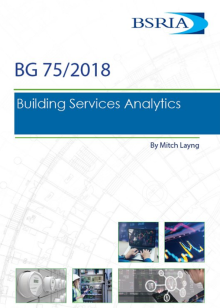Building Services Analytics - BG 75 2018
In December 2018, BSRIA launched Building Services Analytics – BG 75/2018, written by BSRIA member and Energy Consultant at Layng Energy Solutions, Mitch Layng.
BG 75 provides guidance to building owners and to those involved in the design, construction and operation of buildings and building services about how the correct capture and analysis of data can be used to drive improvement in building performance.
Building services can generate vast amounts of data. It is becoming increasingly important for building owners, operators and service providers to make use of this data and analytics. BG 75/2018 highlights what is involved with this complex and growing management process and what considerations should be given to implementing building services analytics.
One of the key drivers to implementing analytics in buildings, particularly in relation to building services, is energy performance. Data analytics related to energy meters has been in existence far longer than it has for other building services. Sadly, metering is often incorrectly specified, designed, installed and operated, resulting in many problems in terms of data validation and accuracy. BG 75/2018 will assist in ensuring the correct metering strategy is designed and implemented, resulting in better-performing buildings.
It also provides information and references about analytics for the whole building services industry, from designers, installers and building operators, to occupiers and customers. This will result in financial savings from energy efficiencies and will deliver a better, safer and more productive environment.
Many components of building services are now capable of communicating valuable data about their environment and operation. The Internet of Things (IoT) is drastically changing many industries, including the building services sector. Access to this data opens up new opportunities for businesses, building owners and building operators to improve the operation of their systems.
The key drivers for this are to:
- Reduce costs.
- Optimise energy consumption.
- Streamline and improve maintenance strategies.
- Reduce carbon emissions.
- Improve occupants’ health and wellbeing.
- Maximise productivity.
- Improve customer experience.
- Ensure compliance with regulations.
- Demonstrate corporate and social responsibility.
- Attract investors.
- Improve reliability of business-critical systems.
- Validate investments in energy savings measures and system upgrades.
Author, Mitch Layng said:
“The leisure and retail sectors in particular are becoming aware that the analysis and reporting of big data creates opportunities to ensure the correct environment is maintained, and the right facilities are available, creating a better experience for the customer.
“The value of big data in the built environment is only just beginning to be realised by the industry as a whole. The range of sensors that are linked to, or part of, plant and equipment is becoming greater. Wearables and mobile devices are ubiquitous and all of these devices are becoming more and more affordable.
“The usefulness of these interconnected devices can be tremendous and ranges from enhancing life safety and security to building automation control and reporting. But many building operators lack convenient ways to turn the flood of data into information they can use to prioritise and act.”
BG 75/2018 can be purchased in pdf and hard copy form at https://www.bsria.co.uk/information-membership/bookshop/publication/building-services-analytics/
--BSRIA
[edit] Related articles on Designing Buildings Wiki
- Building analytics market trends.
- Building services.
- BSRIA.
- BSRIA articles.
- Big data.
- Urban water systems management: A data analytics approach EP 105.
- 5 steps for a healthy data culture in construction.
- Application Programming Interfaces (APIs).
- Artificial intelligence and civil engineering.
- Building Automation and Control System BACS.
- Building information modelling.
- Cyber threats to building automation and control systems.
- Internet of things.
- Making the most of big data.
- Open data.
- Servitisation in construction.
- Servitisation, smart systems and connectivity of instrumentation.
- Smart building.
- Smart construction.
- Smart meter.
- Smart technology.
Featured articles and news
Government consultations for the summer of 2025
A year of Labour, past and present consultations on the environment, the built environment, training and tax.
CMA competitiveness probe of major housing developers
100 million affordable housing contributions committed with further consultation published.
Homes England supports Greencore Homes
42 new build affordable sustainable homes in Oxfordshire.
Zero carbon social housing: unlocking brownfield potential
Seven ZEDpod strategies for brownfield housing success.
CIOB report; a blueprint for SDGs and the built environment
Pairing the Sustainable Development Goals with projects.
Types, tests, standards and fires relating to external cladding
Brief descriptions with an extensive list of fires for review.
Latest Build UK Building Safety Regime explainer published
Key elements in one short, now updated document.
UKGBC launch the UK Climate Resilience Roadmap
First guidance of its kind on direct climate impacts for the built environment and how it can adapt.
CLC Health, Safety and Wellbeing Strategy 2025
Launched by the Minister for Industry to look at fatalities on site, improving mental health and other issues.
One of the most impressive Victorian architects. Book review.
Common Assessment Standard now with building safety
New CAS update now includes mandatory building safety questions.
RTPI leader to become new CIOB Chief Executive Officer
Dr Victoria Hills MRTPI, FICE to take over after Caroline Gumble’s departure.
Social and affordable housing, a long term plan for delivery
The “Delivering a Decade of Renewal for Social and Affordable Housing” strategy sets out future path.
A change to adoptive architecture
Effects of global weather warming on architectural detailing, material choice and human interaction.
The proposed publicly owned and backed subsidiary of Homes England, to facilitate new homes.
How big is the problem and what can we do to mitigate the effects?
Overheating guidance and tools for building designers
A number of cool guides to help with the heat.
The UK's Modern Industrial Strategy: A 10 year plan
Previous consultation criticism, current key elements and general support with some persisting reservations.
Building Safety Regulator reforms
New roles, new staff and a new fast track service pave the way for a single construction regulator.


























